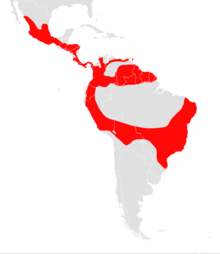Geoffroy's Tailless Bat
| Geoffroy's Tailless Bat | ||||||||||||
|---|---|---|---|---|---|---|---|---|---|---|---|---|

Anoura geoffroyi |
||||||||||||
| Systematics | ||||||||||||
|
||||||||||||
| Scientific name | ||||||||||||
| Anoura geoffroyi | ||||||||||||
| Gray , 1838 |
Geoffroy's Tailless Bat ( Anoura geoffroyi ) is a bat species from the leaf-nosed family (Phyllostomidae), which is native to Central and South America. The species was named after the zoologist Étienne Geoffroy Saint-Hilaire .
description
Geoffroy's Tailless Bat is a medium-sized, tailless bat with an average total length of 69.2 mm. Like all representatives of the flower bats , it also has an elongated snout, with the upper jaw being shorter than the lower jaw. The fur is brown and the bases of the arms and legs are densely hairy.
Way of life
During the day, colonies of 20 to 75 animals use caves and tunnels as hanging places. The largest colony ever observed consisted of about 300 individuals. Geoffroy's Tailless Bat hangs in caves mostly in places with daylight. The roosts are often shared with other bat species and regionally also with fat swallows . Laboratory experiments have shown that Geoffroy's Tailless Bat has excellent vision, but uses echolocation for orientation in the absence of visual stimuli . When looking for nectar, the sense of smell also plays an important role over long distances.
Geoffroy's Tailless Bat feeds on nectar, pollen and insects, although their relative proportions can differ regionally. Visiting flowers makes Geoffroy's Tailless Bat an important pollinator of various neotropical flowering plants, including hibiscus , ceiba , marcgravia and agave .
In Trinidad, females become pregnant in July or August and give birth to the young in late November. In Bolivia, however, pregnant animals were caught in June and in Peru between May and August. In Brazil it has been found that the suckling period is synchronized with the flowering period of various plants. It is therefore assumed that the reproductive time depends on the availability of food and can therefore differ regionally. In the first time after birth, the young gain 1 g per week. They start their first flight attempts as soon as they reach half the weight of a fully grown animal.
distribution and habitat
The distribution of Geoffroy's Tailless Bat ranges from Mexico to Venezuela to French Guyana , as well as Peru to southern Brazil without the Amazon basin . Their population is classified by the IUCN as stable and non-threatened thanks to their widespread distribution and likely large populations.
literature
- J. Ortega, I. Alarcón: Anoura geoffroyi , Mammalian Species , No. 818 (2008): pp. 1-7. - doi : 10.1644 / 818.1
Web links
swell
- ↑ J. Chase (1983) Differential responses to visual and acoustic cues during escape in the bat Anoura geoffroyi: cue preferences and behavior. Animal Behavior 31, pp. 526-531
- ↑ Anoura geoffroyi in the IUCN Red List of Threatened Species .
